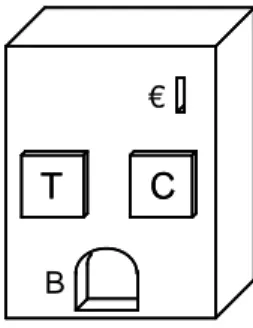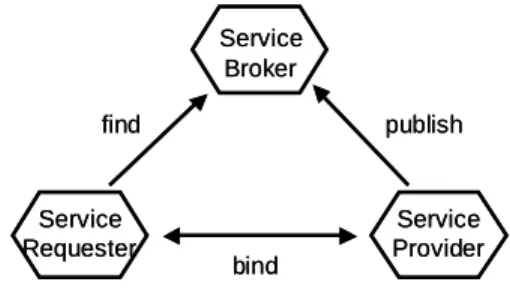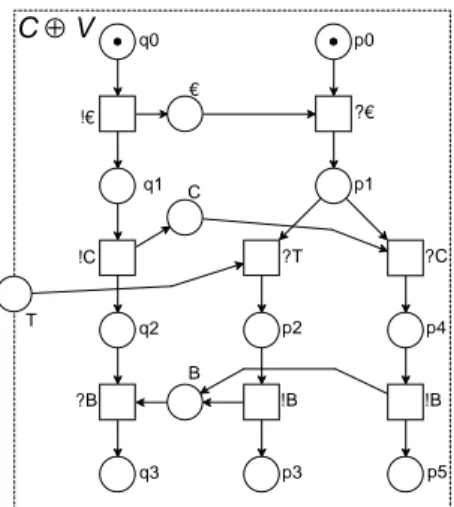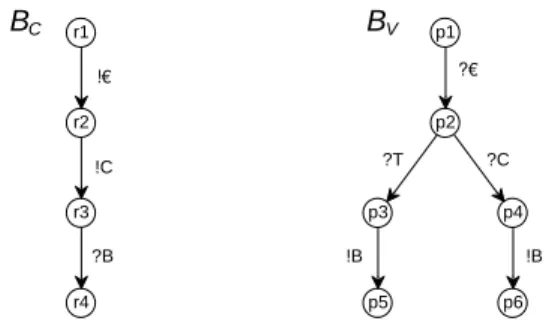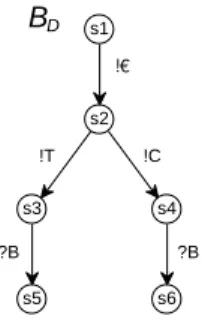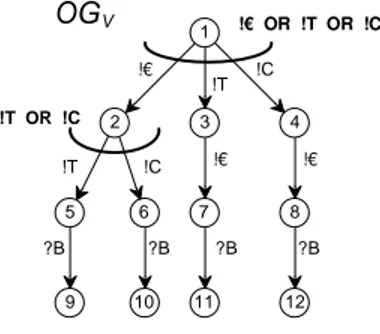An Operating Guideline Approach to the SOA
Peter Massuthe, Wolfgang Reisig, and Karsten Schmidt Humboldt-Universit¨at zu Berlin
Institut f¨ur Informatik Unter den Linden 6
D-10099 Berlin
{massuthe, reisig, kschmidt}@informatik.hu-berlin.de
Abstract Interorganizational cooperation is more and more organized by the paradigm of services. The service-oriented architecture (SOA) provides a general framework for service interaction. It describes three roles,service provider,service requester, andservice broker, together with the three operationspublish,find, andbind.
We provide a formal method based on Petri nets to model services and their cooperation. We characterize well-behaving pairs of requester’s and provider’s services and suggestoperating guidelinesas a convenient and intuitive artifact to realizepublish. Then, the find operation reduces to a matching problem between the requester’s service and the operating guideline.Binding of a requester’s and a provider’s service is therefore guaranteed to result in a well-behaving cooperating service.
Keywords:Services, SOA, Petri nets, Operating guidelines
1 Introduction
A service can be viewed as an artifact consisting of an identifier (id), an interface (e.g. specified in WSDL [4]), and internal control (e.g. a workflow). A service can typically not be executed in isolation – services are designed for being invoked by other services, or for invoking other services themselves.
Theservice-oriented architecture (SOA) [6] is a promising and increas- ingly influential software architecture providing a general framework for service interaction. It describes three roles of service owners: service provider,service requester, and service broker. A service provider pub- lishesinformation about his service to a repository. The service broker manages the repository and allows a service requester to find an ade- quate service provider. Then, the service of the provider and the service of the requester maybindand start interaction.
Such cooperating services may cause non-trivial communication. Thus, for a given requester’s serviceR, the broker’s task is to select from the repository only those provided servicesP that are guaranteed to inter- act properly withR: The servicesR andP must not deadlock in their interaction or send unanticipated messages, for instance. Thereby, com- patibility of the interfaces ofRandPis not sufficient to guarantee proper interaction.
The broker must decide this task by help of the published information aboutP. In a currently quite popular approach, the published informa- tion is a so-calledpublic view[7, 8], i.e. an abstract versionP0 ofP with a communication behavior equivalent toP.
In this paper, we suggest an alternative: The provider does not pub- lish information abouthis serviceP, but information about all proper servicesRof potentialrequesters, instead. This information is calledop- erating guideline,OGP, forP. In our approach, the operating guideline forP describes, in a compact way, the set of all servicesRthat interact properly withP.
We claim that matching a requester’s serviceRwith an operating guide- lineOGP is less complex than matchingRwith the public viewP0 ofP. IfR matches OGP, we can guarantee that R and P interact properly.
In this paper, we show that services have canonical operating guidelines and it is even possible to compute them. Furthermore, the operating guideline forP typically hides a lot of details about the internal control structure ofP, that the owner ofP might want to keep secret.
In our approach, we considerworkflow services, an important subclass of services with operational behavior described as a workflow. We suggest a formal model based on Petri nets, calledopen workflow nets(oWFNs), to represent workflow services. An oWFN is basically a liberal version of a van der Aalst workflow net [1], enriched with communication places for asynchronous communication. In this paper, we present our approach only for acyclic nets.
With oWFNs, we can model services of providers, as well as services of requesters. We can furthermore compose two oWFNs and obtain a model for both services in interaction. The composition of two oWFNs results in an oWFN, again. Composition can therefore be seen as the re- sult of the SOAbind operation. In our approach, we abstract from every other aspect ofbindas resolving URI, routing, and establishment of com- munication channels. We assume this to be managed by an underlying middleware.
We can formulateproper interactionbetween services as a property of the corresponding composed oWFN, calledweak termination. Each partner oWFNRthat weakly terminates withP, is called astrategy forP. Considering thebehaviorsof all strategies forP, it turns out that there is a uniquemost permissive behavior, i.e.everystrategy forP has a behav- ior that can be obtained through restricting the most permissive one. The most permissive behavior itself then provides the basis for the operating guidelines: We can provide annotations to the most permissive behav- ior that characterize the allowed restrictions to obtain the behaviors of all strategies. Operating guidelines (i.e. the annotated most permissive behavior) is then provided to the service broker, thus realizingpublish.
This way, matching a requester’s service Rwith a published operating guidelineOGP reduces to check whether or not the behavior of R is a subtree ofOGP that satisfies the annotations.
The rest of the paper is structured as follows. In Sec. 2, we consider the essential aspects of services, and characterize the class of workflow services. Section 3 introduces the schema of the service-oriented architec-
ture with the three roles for service owners and the standard operations publish,find, andbind.
Our model of workflow services, open workflow nets, is described in Sec. 4. This includes operational behavior, means of communication, composition, and desired properties of cooperating oWFNs.
Section 5 then introduces our main construct, operating guidelines. Op- erating guidelines turn out to be a convenient and elegant instrument to realize publish. Finally, in Sec. 6, we apply operating guidelines to decide the existence of a fitting provider’s service for a given service of a requester, thus realizingfind.
2 Services
Nowadays, cooperation across borders of enterprises is increasingly im- portant. Functionalities are sourced out or so-called virtual enterprises for specific tasks are formed.
In this setting,services play an important role. A service basically en- capsulates self-contained functions that interact through a well-defined interface. Recent publications apply the term service in different con- texts with varying denotations. In this paper, we assume the essentials of a service to include anidentifier (id), itsinterface, and itsoperational behavior. Thereby, the interface of a service describes means to commu- nicate with its environment during execution. The operational behavior of a service is basically a set of operations to be executed according to some internal control structure.
The well-known class ofweb services is an implementation of services with an interface specified in WSDL and an id given by an URI.
In this paper, we concentrate on services with operational behavior de- scribed as aworkflow, i.e. an implemented business process. Such services will be denoted as workflow services. Workflow services have become particularly important since the establishment of BPEL [5] as a widely excepted language to describe web services. BPEL provides control struc- tures that typically occur in workflows.
T C
T C
B
Figure 1.A vending machine that sells, for 1 Euro, either a cup of tea (buttonT), or coffee (buttonC).
Examples of workflow services include online banking systems (which are web services as well) and car rentals (which are not necessarily web services). A Java program is certainly no workflow services (but may be a web service).
As a running example, we consider the workflow service of a beverage vending machine, as outlined in Fig. 1. The service provided by this machine expects a coin (C–– ) to be inserted and one of the buttonsTand Cbeing pressed. The service then reacts with delivering a beverage, i.e. a cup of tea (in caseThas been pressed) or a cup of coffee (in caseChas been pressed).
3 The Service-Oriented Architecture (SOA)
Generally, services are not executed in isolation, but in cooperation with other services (e.g. by exchanging messages). For that purpose, service interaction is organized by the SOA. The SOA assumes that services are run by agents, with agents entering (and leaving) the scene dynamically.
The services of these agents are intended to communicate with each other. This requires an agent to establish new communication facilities with other agents (in particular in case the agent entered the scene only recently).
In the SOA, such communication facilities are established by help of a service broker. Each agent is assumed to approach the broker in one of two roles: As aservice provider, i.e. in the role of delivering some service, or as a service requester, i.e. in the role of using an already provided service.
Service Broker
Service Provider Service
Requester
publish find
bind Service
Broker
Service Provider Service
Requester
publish find
bind
Figure 2.The service-oriented architecture (SOA).
Therefore, the provider, requester, and broker agents execute the follow- ing three operations:
A service provider sends information to the service broker, indicating how a service requester may use his service. The service broker then stores this information together with the provider’s id in a repository.
This operation is calledpublish.
The SOA operationfind means that a requester sends a description of his requested service to the service broker. The broker selects a fitting one and returns the corresponding provider’s id.
Finally, the requester establishes a connection with the provider, and both agents jointly run their respective services, described by the SOA bind operation.
The three roles of agents, together with the three standard operations are outlined in the SOA triangle, depicted in Fig. 2.
The above operations come up with a number of problems:
Publish:The provider has good reasons to keep published information about his service at a minimum. He usually wants (1) to cover business secrets, (2) to retain maximal flexibility to update his service without giving notice to providers and brokers, and (3) to shield requesters from details they do not need to know.
In this paper, we suggest operating guidelines (to be introduced in Sec. 5) as information to be published about a provider’s service. Operating guidelines serve well as an abstraction from internal details and support flexibility.
Find:Given a service of a requester and the operating guideline for a provider, a broker has to decide whether or not the requester’s and the provider’s services would interact properly.
In this paper, we describe how a broker may decide this question by matching the requester’s service with operating guidelines.
Bind:Through our operating guidelines approach topublishandfind, a requester’s service is guaranteed to successfully cooperate with the ser- vice of a broker’s recommended provider (e.g. they do not deadlock). We completely abstract from implementation details concerning the estab- lishing of communication channels between provider and requester (such as resolving an URI, routing, etc.). We just suggest means to describe the behavior of single services as well as their cooperation.
Summing up, the SOA schema requires a proper representation of ser- vices and their cooperation, together with adequate descriptions of the operationspublish andfind.
The rest of this paper suggests corresponding features for the subclass of services, called workflow services.
4 Models of Workflow Services
A solution to the problems described above requires a proper model of workflow services. A model of workflows was already suggested by van der Aalst [1]. He defines a special class of Petri nets,workflow nets(WFNs), that adequately describe the control structure of workflows. Since work- flow services are supposed to communicate with other workflow services, additional constructs for modeling communication channels are needed.
We suggestopen workflow nets(oWFNs) for this endeavour, essentially a liberal version of van der Aalst workflow nets, enriched with communica- tion places. Each communication place of an oWFN models a channel to send (receive) messages to (from) another oWFN. Thereby, we abstract from data and just model the occurrence of messages as undistinguish- able tokens.
We assume the usual representation of Petri netsN= (P, T, F), withP andT the set ofplacesandtransitions(graphically, circles and squares),
and a setF⊆(P×T)∪(T×P) ofarcs, graphically: arrows. Amarkingis a mappingm:P →N(graphically,m(p) black tokens onp). As usual, a transitiontisenabledat a markingmif for each placepwith (p, t)∈F, m(p)≥1.
If enabled atm,occurrenceoftthen yields the markingm0withm0(p) = m(p)−1 if (p, t)∈F and (t, p)∈/F,m0(p) =m(p) + 1 if (t, p)∈F and (p, t)∈/F, andm0(p) =m(p) otherwise.
Anopen workflow net is a Petri netN= (P, T, F) together with 1. two sets in, out ⊆ P, such that for all transitions t ∈ T holds: if
p∈in(p∈out) then (t, p)∈/F ((p, t)∈/F),
2. a distinguished markingm0, called theinitial marking, and 3. a setΩof distinguished markings, called thefinal markingsofN. The places inin(out) are called input(output) places. The setin∪out is called theinterface ofN. Theinner ofN can be obtained fromN by removing all interface places, together with their adjacent arcs.
Graphically,N is surrounded by a dashed box, with the interface places on its boundary. As a convention, we label a transitiont connected to an input (output) placexwith ?x(!x).
?T ?C
!B !B
p0
p1
p2 p4
p3 p5
C
T B V
Figure 3.An oWFNV for the vending machine of Fig. 1.
As an example, Fig. 3 shows an oWFN,V, modeling the vending machine of Fig. 1. The places–– ,C T,C, andBdenote an inserted coin, the buttonT orCpressed, and a beverage delivered, respectively. There are two final markings ofV: a single token onp3or a single token onp5.
We are now ready to define the composition of oWFNs, reflecting the interplay between workflow services.
Conceiving the vending machine of Fig. 1 as a provider’s service, a cor- responding customer would insert a coin, press one of the buttons and later on receive the beverage.
!C
?B q0
q1
q2
q3
C
B C
Figure 4.A customer’s oWFN,C, for the vending machineV that wants coffee.
Fig. 4 models a customer,C, of the vending machine, pressing thecoffee button. This model is again an oWFN. Further examples can be found in [12].
The interaction of two oWFNs is reflected by their composition. Two oWFNsM and N may have some elements in common. Nevertheless, without loss of generality we may assume that M and N only share input- and output elements:
(PM∪TM)∩(PN∪TN)⊆(inM ∪outM)∩(inN∪outN) (1) This property in fact holds for the two oWFNsV and C: They share nothing but the interface places–– ,C C, andB.
Assuming (1), composition of two oWFNsM andN is an oWFN again, denotedM⊕N, and constructed essentially as the component-wise union of M and N. So let M ⊕N be defined by PM⊕N =def PM ∪PN, TM⊕N=def TM∪TN,FM⊕N=def FM∪FN.
Each place inoutM∩inN (or ininM ∩outN) turns into an inner place ofM⊕N. WithI=def (outM∩inN)∪(inN∩outM), letinM⊕N=def
(inM∪inN)\I andoutM⊕N=def (outM∪outN)\I.
For markingsmM andmN ofM andN, respectively, letmM ⊕mN be a marking of M⊕N, defined forp ∈ PM⊕N by (mM ⊕mN)(p) =def
mM(p) +mN(p), wheremM(p) = 0 ifp /∈PM andmN(p) = 0 ifp /∈PN. Then, letm(M⊕N)0 =def mM0⊕mN0 andmM⊕N ∈ΩM⊕N iffmM⊕N = mM⊕mN for somemM ∈ΩM and somemN∈ΩN.
As an example, Fig. 5 shows the oWFN C⊕V. This oWFN has two terminal markings,m1 and m2, with m1(q3) =m1(p3) = 1,m2(q3) = m2(p5) = 1, and no tokens on all other places. Notice thatinC⊕V ={T}
andoutC⊕V =∅.
Fig. 6 shows another oWFN,E. Assume one terminal marking forE, with a token onr2and no token elsewhere.Emodels an erroneous customer service of the vending machine, as the customer apparently
”forgets“ to
!C
?B q0
q1
q2
q3
?T ?C
!B !B
p0
p1
p2 p4
p3 p5
C
T
B
C⊕V
Figure 5.The composed oWFNC⊕V of Fig. 3 and Fig. 4.
press one of the machine buttons, and both services deadlock. Summing up, the oWFNC is an
”adequate“ partner forV, whereasE is not.
?B r0
r1
r2
B E
Figure 6.An erroneous partner oWFNEforV.
In technical terms, a markingmof an oWFN is adeadlock ifmenables no transition at all. It is easy to see that in the composed oWFNC⊕V, the only reachable deadlock is a final marking. In contrast, in the oWFN E⊕V (not shown here), the markingmwithm(r1) =m(p1) = 1 and m(p) = 0 for all other placesp∈PE⊕V is a reachable deadlock which is no final marking.
An oWFN in which all deadlocks are final markings is called weakly terminating. Given an oWFNN, we call an oWFNM astrategyforN iff the oWFNN⊕M is weakly terminating. For example,Cis a strategy forV, whereasEis not.
5 Publish
As mentioned earlier in this paper, information published by a ser- vice provider on his serviceP must enable the service broker to decide whether or not a requester’s service R is a strategy forP (otherwise, bindingP withRmay result in unexpected behavior). Whether or not R is a strategy for P depends on the internal control structure of P. Hence, it has been proposed to publish a public view P0 of P to the service broker. It is supposed that, by knowingP0, the broker can decide whether or notRwill interact properly withP.
We propose a different approach: Instead of a description of the provided serviceP, we suggest to publish a description of the set of allstrategies (i.e. all properly interacting oWFNs)RforP, directly. In fact, we provide a description of thebehaviors of all strategiesR. We call this description operating guideline forP and writeOGP.
In the remainder of this section, we give brief answers to the following questions for a given oWFNP: (1) What is a behavior? (2) How does the operating guidelineOGP look like? (3) How can it be computed? (4) Why does it cover all strategies forP?
r1
r2
r3
r4
!C
?B
BC p1
p2
p3
p5
p4
p6
?C
!B
!B
?T
BV
Figure 7.The behaviorsBC andBV of the oWFNsCandV, resprespectively.
Thebehaviorof a usual Petri net can be represented as a reachability tree. This notion is, however, not adequate for oWFNs, since the marking on the interface places can be changed by the environment. Thus, we describe the behavior of an oWFNN by a slightly different structure.
We first compute the reachability tree of the inner of N (see Sec. 4).
Due to our restriction to acyclic oWFNs, the reachability tree is finite.
Then, each edge in the reachability tree is annotated with !x(?x) if the corresponding transition inN is connected to an output (input) placex, and withτ, otherwise. This answers question (1) stated above.
Figure 7 shows the behaviors BC and BV of the oWFNs C and V of Fig. 4 and Fig. 3, respectively.
In the following, to answer question (2), we first present the two in- gredients to operating guidelines for P: the most permissive behavior of strategies for P and annotations how to derive the behaviors of all
strategies. Then, we sketch the algorithms to compute both ingredients, answering questions (3) and (4).
These answers rely on results proven in [13, 11] concerning behaviors of strategies. For the purpose of simplicity only, we constrain the consider- ations in this paper todeterministic behaviors of strategies. A behavior is deterministic iff every edge of the behavior has exactly one expression
!xor ?yattached (i.e. there is no silent moveτ), and there is no node in the behavior where two leaving edges have the same expression attached.
All behaviors shown in this paper are deterministic.
Let the set of the (deterministic) behaviorsBR of all strategiesR for P be denoted byBP. We can establish a (partial order) relation, more permissive, to behaviors ofBP: A behaviorB is more permissive than a behaviorB0 ifB0is isomorphic to a subtree ofB containing the root.
s1
s2
s3
s5
s4
s6
!C
?B
?B
!T
BD
Figure 8.A more permissive behaviorBD of a customer, who decides.
As an example, Fig. 8 shows the behavior BD of some customer D of the vending machine, who first inserts a coin and thendecides for coffee or tea. BD is more permissive than BC, whereas neither BC is more permissive thanBV, norBV is more permissive thanBC.
In [13, 11], we show that, for every oWFNP, the setBPhas a unique most permissive element, themost permissive behavior,B∗. Consequently, we call every oWFNR with the most permissive behavior as its behavior (i.e.BR =B∗), amost permissive strategy forP. While the most per- missivebehavioris unique, most permissive strategies are not. There are typically many structurally different Petri nets that share the same be- havior. In particular, our presented concept of behavior does not distin- guish arbitrary interleaved transitions from truly concurrent transitions.
The main property of the most permissive behaviorB∗ is that it com- prises all behaviors of strategies forP: Every behaviorBRof a strategy R forP is (isomorphic to) a subtree of B∗. Thus, the most permissive behavior serves as the first ingredient to the operating guideline forP.
Unfortunately, the converse is not true. Not every subtree of the most permissive behavior is itself a behavior of a strategy. Thus, the remaining problem is to distinguish those subtrees of the most permissive behavior which are behaviors of strategies from those subtrees which are no be-
haviors of strategies. Our solution to this task is again based on a result proven in [13, 11]:
Given a provided oWFNPand a behaviorBRof some requester’s service R, we can decide for each nodeqR of BR whether or not it can cause a deadlock in R⊕P. This is basically determined by the edges that leaveqR: Whether or not R is a strategy for P depends on present or missing edges inBR. Thus, we code the constraints for edges leavingqR
as a boolean formula over edge labels and annotate it toqR.BRsatisfies these constraints if and only ifRis a strategy.
Since the most permissive behaviorB∗is a behavior of some strategy, we can annotateB∗, too. A subtree ofB∗ is thus a behavior of a strategy if and only if it still satisfies the attached annotations. The annotations to the nodes of B∗ constitute the second ingredient and complete the operating guideline forP. This answers question (2) stated above.
As an example, the operating guidelineOGV for the vending machineV (of Fig. 3) is depicted in Fig. 9. The possibility to first press a button and then inserting a coin comes from the proposed asynchronous communi- cation. The annotations to nodes which have only one outgoing edge are skipped.
1
3
5
9
8
12
!C
?B
?B
!T
!T
!C
2 4
7
11
?B 6
10
?B
!T OR !C
OGV
Figure 9.The operating guidelineOGV for the vending machineV.
The rest of this Section is devoted to questions (3) and (4). We sketch the algorithms to construct the most permissive behavior and to anno- tate the nodes and argue why operating guidelines cover all behaviors of strategies.
The most permissive behavior for an oWFN P can be constructed as follows. Consider, as a starting point, the complete, deterministic behav- iorBC of some partner oWFNRwhere for every node and every input (output) placexofP, there is an outgoing edge labeled !x(?x). We can limit the depth ofBCby the depth of the behaviorBP ofP. Obviously, every behaviorBR of a strategy forP is a subtree ofBC.
Next, we compute a transition system from the composition ofBCwith BP. A state of the composed system consists of a stateqofBC, a state pofBP, and a multiset (bag)M of pending messages.
Then, we remove, in an iterative process, those nodes q from BC for which there is a bad node [q, p, M] in the composed system, i.e. a node which represents an undesired situation like a deadlock that is no final marking, or unconsumable pending messages. For the removed states, we can show that they cannot be part of the behavior of any strategy forP. Thus, every behavior of strategies remains a subtree ofBCobtained after each iteration. Finally, we can show that as soon as the iterative process of removing states terminates, the remaining behavior (if any) is in fact the behavior of a strategy - and even the most permissive behaviorB∗. This problem is, in fact, a problem known in the literature ascontroller synthesis[3, 10].
To annotate the nodes ofB∗, consider again the transition system com- posed fromB∗andBP. In that tree there is no bad node (since it would have been removed by the above algorithm). Removing further nodes (with adjacent edges) in B∗ results in removing multiple nodes (and edges) in the composed system. This may cause deadlocks or pending messages are not consumed anymore. Hence, other nodes in the com- posed system may become bad nodes. If this happens, the considered node must not be removed. This can easily be expressed by a boolean formula over the labels of outgoing edges. These formulae are attached to each node inB∗and express exactly, which subtrees ofB∗are strategies itself. This completes the answers to the questions (3) and (4).
To summarize, the operating guideline for an oWFN P can be con- structed automatically and only by knowingP. As we assume the con- struction is done by the owner of P, this is acceptable. Furthermore, the annotations just reflect needed actions of the environment such that the composed system does not deadlock. The annotations do not reflect why a deadlock can be reached, nor how the deadlock looks like. When published, operating guidelines therefore hide most details about the in- ternal control structure of the provided service, that the service provider might want to keep secret.
The presented algorithm to construct the most permissive behavior is just a theoretic algorithm that comes from a constructive proof of the existence ofB∗in the setBP. Its starting point, the complete, determin- istic behavior BC may become rather large for realistic services. Even larger is the composed system ofBC andBP, needed to characterize the nodes ofBC.
In current research, we develop efficient representations of operating guidelines as binary decision diagrams (BDDs) [2], as well as the con- struction of operating guidelines directly as a BDD. BDDs are a data structure that proved to be capable of representing large transition sys- tems in the area of model checking. Preliminary results in the application of BDDs representing operating guidelines are promising.
6 Find
Matching a requester’s service with an operating guidelineOGP is rather simple. Given an oWFNRof the requester, we first compute its behavior, BR. This is simple and well-understood state space generation. Then, we
need to check whetherBR(a) is isomorphic to a subtree ofOGP and (b) satisfies the annotations. Thereby, a literal ?x(!x) at some node ofOGP
is evaluated totrueif there is an outgoing edge from the corresponding node inBRlabeled ?x(!x) and evaluated tofalse, otherwise.
It is easy to see thatBC andBDmatchOGV, whereas the behaviorBE
of the erroneous partner oWFNEwould not matchOGV.
Checking the subtree property can be solved by a coordinated depth-first search through both behaviors. Its run-time is linear in the size of R’s behavior. Checking the annotations amounts to computing a value of a boolean formula and can thus be implemented efficiently. Thus, thefind procedure based on operating guidelines turns out to be very efficient.
In contrast, afindbased on public views is a more complex operation.
Given a requesting serviceRand a public viewP0of a provided serviceP, a service broker must decide whetherRis a strategy forP. Currently, the only available approach to this problem is to build the system composed ofP0 and R and to check its state space for deadlocks and end states with unconsumed messages. The size of the state space is typically in the same order of magnitude as the number of states ofP0times the number of states ofR. Checking the state space for deadlocks is linear in that number and thus more complex than matchingRwithOGP.
The reader might argue that a more complexfindmay be compensated by the fact that public view generation is less complex than generating operating guidelines. We cannot verify statements about the complexity of public view generation, since we do not know any convincing solu- tion to public view generation. The only formal approach known to us is [8] where a few sound abstraction rules for services are proposed which preserve strategies. It is, however, unclear whether the generated pub- lic views satisfy the requirement of being sufficiently distinct from the original service to keep the service itself secret. Besides these doubts, an efficientfindis still more important than an efficientpublish. Thepublish operation is performed once by a provided service. Find instead, that is, matching a requesting service against a public view or an operating guideline, is performed many times. This is due to the fact that one and the same requesting service must be checked against many provided ser- vices before a matching service can be found. We thus believe that the operating guidelines approach is more suitable to the SOA than the pub- lic view approach. For a more detailed discussion on public views and operating guidelines see [9].
7 Conclusion
We propose oWFN as a formal model for services that use workflows as their internal control structure. We showed that it is possible to auto- matically compute, for an oWFNP, an operating guidelineOGP which characterizes the set of all (deterministic) behaviors of strategies forP. We propose to useOGP as information published in service repositories.
This way, it is easy for the service broker to assign well-behaving pairs of provider’s and requester’s services: the requester’s service must match the operating guideline published for the provided service. Generating an
operating guideline may be complex, but we expect that this complexity can be managed through the use of advanced technology developed in the area of model checking. In turn, matching a service with an operat- ing guideline is considerably simpler than checking compliance between a requester’s service and a public view of a provided service.
We see several directions for future research. First, we need to extend the approach to services containing cycles. We have a number of pre- liminary results on this matter. Second, we study specialized operating guidelines, characterizing, e.g., the set of all those strategies of the con- sidered vending machine that inevitable lead to the delivery of coffee.
Third, we investigate further important aspects which are relevant for selecting a service such as real-time constraints or cost models. We want to extend the concept of operating guidelines to those aspects.
We are convinced that our approach is well suited to implement the ser- vice discovery outlined in the SOA triangle. Our concept is quite close to those guidelines that are attached to real vending machines. The concept of operating guidelines has thus been already successful in every-day life for a long time.
References
1. W. M. P. van der Aalst. The application of petri nets to workflow management.Journal of Circuits, Systems and Computers, 8(1):21–
66, 1998.
2. Randal E. Bryant. Graph-based algorithms for Boolean function manipulation. IEEE Transactions on Computers, C-35(8):677–691, August 1986.
3. C.G. Cassandras and S. Lafortune. Introduction to Discrete Event Systems. Kluwer Academic Publishers, 1999.
4. Erik Christensen, Francisco Curbera, Greg Meredith, and Sanjiva Weeravarana. Web Service Discription Language (WSDL) 1.1. Tech- nical report, Ariba, International Business Machines Corporation, Microsoft, March 2001.
5. F. Curbera, Y. Goland, J. Klein, F. Leymann, D. Roller, and S. Weerawarana. Business Process Execution Lan- guage for Web Services, Version 1.1. Specification, BEA Systems, IBM, Microsoft, SAP, Siebel, 05 May 2003.
http://msdn.microsoft.com/library/default.asp?url=/library/en- us/dnbiz2k2/html/bpel1-1.asp.
6. Karl Gottschalk. Web Services Architecture Overview.
Ibm whitepaper, IBM developerWorks, 01 September 2000.
http://ibm.com/developerWorks/web/library/w-ovr/.
7. F. Leymann, D. Roller, and M. Schmidt. Web services and business process management. IBM Systems Journal, 41(2), 2002.
8. A. Martens.Verteilte Gesch¨aftsprozesse - Modellierung und Verifika- tion mit Hilfe von Web Services. PhD thesis, Institut fr Informatik, Humboldt-Universit¨at zu Berlin, 2004.
9. P. Massuthe and K. Schmidt. Operating guidelines - an alternative to public view. Techn. Report 189, Humboldt-Universit¨at zu Berlin, 2005.
10. P.J. Ramadge and W.M. Wonham. Supervisory control of a class of discrete event processes. SIAM J. Control and Optimization, 25(1):206–230, 1987.
11. W. Reisig, K. Schmidt, and Ch. Stahl. Kommunizierende Gesch¨aft- sprozesse modellieren und analysieren. Accepted for Informatik – Forschung und Entwicklung, 2005.
12. Wolfgang Reisig. Modeling- and analysis techniques for web services and business processes. InFMOODS, volume 3535 ofLecture Notes in Computer Science, pages 243–258, 2005.
13. K. Schmidt. Controllability of business processes. Techn. Report 180, Humboldt-Universit¨at zu Berlin, 2004.
